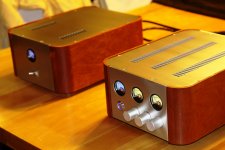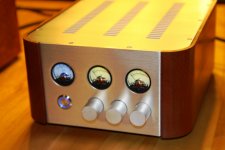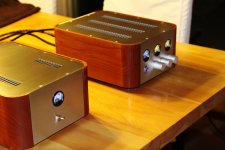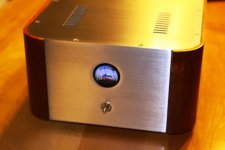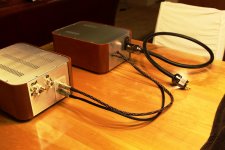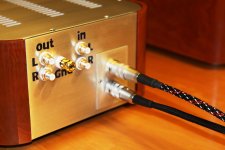Biasing again
After initial setup I let the unit warm up with the top on the chassis, and the after an hour or so the TP1-TP2 voltage climbed quite a bit. I increased the rail voltage a bit to reduce the TP1-TP2 voltage to around 3.6V. Like any good OCD-DIYer I was trying to get it to exactly 3.6V. Then I re-read some older posts here, where Salas said the target is 3.6 +/-1 V -- so a pretty wide range.
Now I find that when I turn on the Folded when it is cold, the TP1-TP2 voltage is quite low. After 10 minutes or so it is still below 2V. It eventually warms up and rises to 3.6V, but it takes more than half an hour, probably more like an hour.
1. Am I insane for even thinking about this?
2. Should I reduce the rail voltage to get the TP1-TP2 voltage above 2.6V faster, and not worry if it goes up to around 4V or more?
I know this is setting the Vcb of Q3, but I don't know what the importance or effect of this is, or why 3.6V is better or worse than any other value. What exactly are we trying to do with this adjustment?
Also, keep in mind I am in Canada and it's pretty cold this time of year. When I turn the unit on "cold" it's probably <15C, and the interior of the case with the lid on gets up to about 26C. Several months from now ambient conditions will be very different.
Advice welcome!
After initial setup I let the unit warm up with the top on the chassis, and the after an hour or so the TP1-TP2 voltage climbed quite a bit. I increased the rail voltage a bit to reduce the TP1-TP2 voltage to around 3.6V. Like any good OCD-DIYer I was trying to get it to exactly 3.6V. Then I re-read some older posts here, where Salas said the target is 3.6 +/-1 V -- so a pretty wide range.
Now I find that when I turn on the Folded when it is cold, the TP1-TP2 voltage is quite low. After 10 minutes or so it is still below 2V. It eventually warms up and rises to 3.6V, but it takes more than half an hour, probably more like an hour.
1. Am I insane for even thinking about this?
2. Should I reduce the rail voltage to get the TP1-TP2 voltage above 2.6V faster, and not worry if it goes up to around 4V or more?
I know this is setting the Vcb of Q3, but I don't know what the importance or effect of this is, or why 3.6V is better or worse than any other value. What exactly are we trying to do with this adjustment?
Also, keep in mind I am in Canada and it's pretty cold this time of year. When I turn the unit on "cold" it's probably <15C, and the interior of the case with the lid on gets up to about 26C. Several months from now ambient conditions will be very different.
Advice welcome!
Hi Salas,
I'm done.
The best sound came from 47pF for C2Ys. I made tightly matched pair with choice of two caps with 44.3pF (Germany made KS Styroflex 160V). I also corrected umbilical cord braid connection to 0 in PSU box.
Please see attached pics.
I'm done.
The best sound came from 47pF for C2Ys. I made tightly matched pair with choice of two caps with 44.3pF (Germany made KS Styroflex 160V). I also corrected umbilical cord braid connection to 0 in PSU box.
Please see attached pics.
Attachments
Wow Alex!
Very, very stylish! Gems...
Regards
Thank you.
Hi Salas,
I'm done.
The best sound came from 47pF for C2Ys. I made tightly matched pair with choice of two caps with 44.3pF (Germany made KS Styroflex 160V). I also corrected umbilical cord braid connection to 0 in PSU box.
Please see attached pics.
Fine aesthetics finish. Congratulations.
After initial setup I let the unit warm up with the top on the chassis, and the after an hour or so the TP1-TP2 voltage climbed quite a bit. I increased the rail voltage a bit to reduce the TP1-TP2 voltage to around 3.6V. Like any good OCD-DIYer I was trying to get it to exactly 3.6V. Then I re-read some older posts here, where Salas said the target is 3.6 +/-1 V -- so a pretty wide range.
Now I find that when I turn on the Folded when it is cold, the TP1-TP2 voltage is quite low. After 10 minutes or so it is still below 2V. It eventually warms up and rises to 3.6V, but it takes more than half an hour, probably more like an hour.
1. Am I insane for even thinking about this?
2. Should I reduce the rail voltage to get the TP1-TP2 voltage above 2.6V faster, and not worry if it goes up to around 4V or more?
I know this is setting the Vcb of Q3, but I don't know what the importance or effect of this is, or why 3.6V is better or worse than any other value. What exactly are we trying to do with this adjustment?
Also, keep in mind I am in Canada and it's pretty cold this time of year. When I turn the unit on "cold" it's probably <15C, and the interior of the case with the lid on gets up to about 26C. Several months from now ambient conditions will be very different.
Advice welcome!
Its mainly the warm up of the 369s cycle with their own dissipation that lets them draw more current than the delta you got in box which is not much, only 11C above room ambient.
If you will analyse the circuit you will see that this test voltage against a steady ref which are your Leds translates to typically centering the input stage amplifier between max and ground. There is much headroom for the tiny swing the signal demands, still we would want that fairly centered in case of clipping. Which hardly occurs, it takes a wrongly high output cartridge for a chosen gain and a disc with loud pops.
When you see tp1-tp2 low in cold start means there is plenty of voltage across the cascode amp's load resistor. Not insufficient bias, to the contrary. You let time pass so the fets naturally steal a bit of current and it falls in the centre ballpark. Room ambient will make them a bit more enthusiastic but the main concern is the inbox delta not to be too high. The minisinks help to keep the fets in mainly doing it on their own.
Homc and mm gain builds will care much less for warm up or ambient due to the much larger source resistor that brings local feedback and moderates the fet current much more efficiently.
The only way to force those strongly positive tempco fets to a well fixed current would be an active CCS, alas it shoots its current noise right in the heart of the input stage. We dont want that in a 0.52nVrtHz stage for MC. When we got a large margin for signal swing to afford settling time anyway.
I'm done.
Awesome appearance! What do the knobs and dials do?
Salas, thanks for the detailed answer. Would I be better off to:
1. Try for TP1-TP2 ~3.6V when fully warm, and not worry about the lower voltage during the first hour (or never turn it off!).
2. Set TP1-TP2 higher when warm, like ~4.6V, so it gets into the right range faster after turn-on?
Also, what effect does VR1 have on this exactly? When it is fully CCW does it short out R12, increasing current through R13? If I try to keep VR1 closer to the other end, so R12 dominates, would that tend to alter the warm-up behaviour? And when you say "the cascode amp's load resistor", is that R4?
When the unit is cold, for the first minute or two TP1-TP2 is slightly negative, about -150mV but rising fairly quickly. Gets to ~2.6V in about 20-25 minutes, and keeps rising slowly to finish around 3.7V -- I'm not sure how long that takes, I might do some timings tonight (set an alarm and measure every 10 minutes until it's stable).
Again, thanks for the details.
1. Try for TP1-TP2 ~3.6V when fully warm, and not worry about the lower voltage during the first hour (or never turn it off!).
2. Set TP1-TP2 higher when warm, like ~4.6V, so it gets into the right range faster after turn-on?
Also, what effect does VR1 have on this exactly? When it is fully CCW does it short out R12, increasing current through R13? If I try to keep VR1 closer to the other end, so R12 dominates, would that tend to alter the warm-up behaviour? And when you say "the cascode amp's load resistor", is that R4?
When the unit is cold, for the first minute or two TP1-TP2 is slightly negative, about -150mV but rising fairly quickly. Gets to ~2.6V in about 20-25 minutes, and keeps rising slowly to finish around 3.7V -- I'm not sure how long that takes, I might do some timings tonight (set an alarm and measure every 10 minutes until it's stable).
Again, thanks for the details.
Agreed correcting for completely cold is pointless, but I am concerned that this voltage difference doesn't get to the "right" range until about half an hour after turn-on. Of course, I haven't actually listened to this thing yet, no idea what audible difference, if any, results from this.
Salas, thanks for the detailed answer. Would I be better off to:
1. Try for TP1-TP2 ~3.6V when fully warm, and not worry about the lower voltage during the first hour (or never turn it off!).
2. Set TP1-TP2 higher when warm, like ~4.6V, so it gets into the right range faster after turn-on?
Also, what effect does VR1 have on this exactly? When it is fully CCW does it short out R12, increasing current through R13? If I try to keep VR1 closer to the other end, so R12 dominates, would that tend to alter the warm-up behaviour? And when you say "the cascode amp's load resistor", is that R4?
When the unit is cold, for the first minute or two TP1-TP2 is slightly negative, about -150mV but rising fairly quickly. Gets to ~2.6V in about 20-25 minutes, and keeps rising slowly to finish around 3.7V -- I'm not sure how long that takes, I might do some timings tonight (set an alarm and measure every 10 minutes until it's stable).
Again, thanks for the details.
Do as in 1.
Better to have VR1 at middle range. What it does is it alters the current feed through the passive CCS resistor R13. When someone does not have similar enough 369s between channels, VR1 can compensate not to end up with too different Rail+ that could effect the rest of the stages matching between channels.
What Q1, Q2 IDSS and R2, R3, and cartridge output you got?
Agreed correcting for completely cold is pointless, but I am concerned that this voltage difference doesn't get to the "right" range until about half an hour after turn-on. Of course, I haven't actually listened to this thing yet, no idea what audible difference, if any, results from this.
Leave it on, no use turning it off unless you go on vacation.
Rush
Would adding a highish value Thermistor somewhere in the circuit give a more equal cool to hot temperature voltage range.
Correcting for completely cold doesn't achieve much.
Its mainly the 369s own dissipation tempco not the ambient delta, it happens they take time to max out even on own TO-92 mini sinks and small delta like the 11C example in question.
Another possibility is that the example has more actual IDSS input fets than thought and it takes higher R2 R3. Because 1V travel in a box from cold to hot is known but not much more.
Do as in 1.
What Q1, Q2 IDSS and R2, R3, and cartridge output you got?
Going from memory here, but I think the Q1/Q2 (matched quad) were all 11.55mA Idss, R2 and R3 are all 4R99 (a little below your recommended 5R1).
Cartridge is an Ortofon MC15 Super MkII, rated 0.34mV output..
- Home
- Source & Line
- Analogue Source
- Simplistic NJFET RIAA
